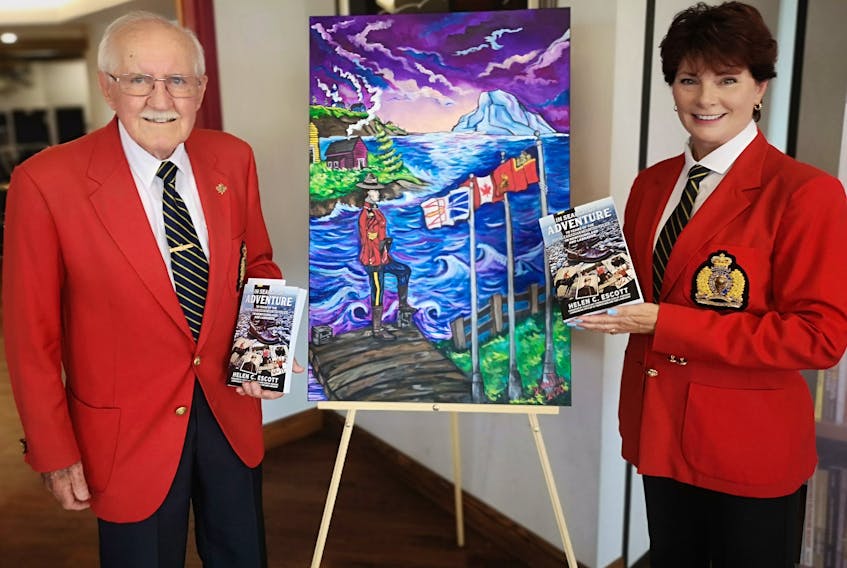Helen Escott is a retired civilian member of the RCMP who created the force’s N.L. Media Relations/Communications Unit and has published a memoir and a pair of crime thrillers.
Here she has compiled 80-odd, usually quite personal, tales inter-linked by RCMP service: most of the book is composed of brief biographies which taken together “tells the stories of who we are.”
The history of the RCMP in our province is largely post-Confederation, when 55 Rangers and 35 members of the Newfoundland Constabulary transitioned to the Canadian police organization (although the first Newfoundlander to join the RCMP – Const. Ernest W. Peyton of Twillingate – actually did so in 1888). The RCMP were then given responsibility over all of Newfoundland and Labrador, excepting St. John’s, with subdivisions eventually opening in Corner Brook, Gander, and Labrador.
In “Ches Parsons: Newfoundland Rangers become Mounties,” we learn most of those Rangers were reduced in rank, a decision which “was never explained … This caused a lot of consternation and chagrin, since (their) education qualifications were far higher than those required to join the RCMP at the time.
The life histories are arranged a rough chronological arc, with distinct milestones (such as “Cheryl LaFosse: One of the first sworn RCMP females”) as the RCMP’s role and arena grows, fluctuates, and modernizes.
Some focus on singular events that illuminate larger issues.
“Wayne Nichols: Now that is pulling a rabbit out of a patrol car!” illustrates the challenges of police work in a small community.
Nichols had transferred from metropolitan Nova Scotia to a place where everyone knew everyone, and writing out a traffic ticket, for example, could be “uncomfortable” for all parties concerned. One night he stopped a speeding car full of men who had gotten off work late and were racing to catch the NHL final. They “were unhappy but very apologetic,” and during the ensuing chitchat one of the men wished he had a fresh rabbit to “have him in the pot” and consume while viewing the hockey game. As it happened, Nichols had just hit a rabbit – an unfortunate side occurrence of patrolling – and he gave it to them. “’It was an exchange I will always remember and one that paid off many times over after that. I became known as ‘not a bad fellow’ and was always given a friendly wave and assistance in the community when required.”
Other happenings cast bigger, even global, shadows.
Assistant Commissioner Gerry Lynch was the N..L RCMP Criminal Operations Officer on Sept. 11, 2001.
“I received a call from the communications centre that an incident had just occurred in the United States.” American airspace was closed and airplanes were coming to local airports, including 38 to Gander. Passengers needed to be deplaned and accommodated, even as the awareness of what had transpired began to seep in: “Terrorism was something that took place elsewhere in the world, not in our own backyard. We did not know if this was an accident, initially, but soon learned it was not.”
There’s also a chapter on the “Second Man Award: When the second man is a woman.”
“In Search of Adventure: 70 Years of the Royal Canadian Mounted Police in Newfoundland and Labrador,” by Helen C. Escott, with a Foreword by Commissioner Ches W. Parsons; Flanker Press; $19.95; 306 pages. — Contributed - SaltWire Network
This was awarded in 2013 to 22 women whose husbands were RCMP officers in remote spots, and who (unpaid) “answered phones, searched female prisoners, and provided prisoners’ meals. They often used their homes as a hotel for visiting senior officers, court judges, doctors, and nurses, to whom they also provided meals and entertainment. It was not uncommon for the detachment or married quarters to serve as a waiting room for persons connecting with a coastal boat, train, or some other form of public transportation.”
One recipient, Ethel Jarvis, remembered that “doing work at the (Burgeo) detachment was often enjoyable but sometimes frightening. She recalled one day when “‘(her husband) Dick was out on a call, and he had to leave me with a rambunctious, mentally ill patient. The man kept calling Dick, and when I went to check on him, the prisoner had escaped his holding area and was pacing in the RCMP office, with a knife on a desk.’”
Escott also makes note of the two RCMP constables who have been killed on duty in the province: Terry Hoey, 21, serving in Botwood in 1958, shot responding to a domestic dispute, and Robert Amey, 24, serving in Whitbourne in 1964, shot by one of a quartet of prisoners who had escaped from Her Majesty’s Penitentiary.
This is not a critical analysis of the RCMP presence and history in the province. The overall tone is of a sense of pride and commitment, accompanied by lots of black and white archival and personal photos.
Joan Sullivan is editor of Newfoundland Quarterly magazine. She reviews both fiction and non-fiction for The Telegram.









